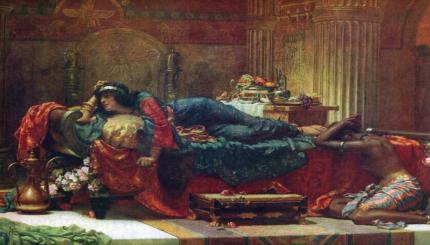
Abby as Vashti, Purim ’98
Little girls don’t usually dress up as Vashti for Purim. Esther is the heroine, after all, and those poofy princess dresses that went on sale after Easter last year make the perfect Esther costume. But we shouldn’t be writing off Vashti so quickly—she’s just as much of a hero as Esther is, albeit for different reasons.
The set-up for the Purim story is a familiar one: Queen Vashti’s expulsion from the palace that creates the demand for a new queen and ultimately puts Esther in a place to be able to save the Jewish people from annihilation at the hands of the king’s evil adviser, Haman.
But that’s not why Vashti is a hero. It’s the details of the set-up—the downfall of Queen Vashti—that are too often overlooked that make her a hero. By skimming through the first chapter of Meglilat Esther (the Scroll of Esther) so we can get to the grogger-inducing, Haman-filled chapters later in the scroll, we miss a valuable opportunity to see an unprecedentedly early example of feminism. This idea has picked up some traction, and I tend to agree with where these ideas land.
So let’s take a look.
We meet King Ahashveros just as he’s finishing up a 180-day long party and beginning another “feast,” this time for all the citizens of Shushan, the capital. By the seventh day of this second round of parties, the king’s heart is “merry with wine”; in this drunk state, he sends for his wife Vashti, wanting to show off her beauty to all those in attendance. Vashti refuses. The king is furious– so furious he gets rid of her and seeks a new queen.
And that’s where the heroism begins, right there when Vashti says “no.” Rejecting the king’s request was a big deal—so big, in fact, that one of Ahashveros’ councilmen warned that it would have ripple effects across the entire kingdom. Vashti’s refusal was a stain upon the perceived control of the king over his kingdom. What was worse, the king’s adviser noted, was that other women would follow by example and use Vashti’s refusal as authorization to disobey their own husbands.
As a woman in a position of power, Vashti did exactly what she should have: she used her public status to lead by example, empowering citizens against abuse. It’s not just that Vashti took a stand against the objectification of her own body. Vashti served as a role model for the entirety of the female population of the kingdom… and for girls today looking for strong female role models. Two thousand years later, women’s rights advocate and abolitionist Harriet Beecher Stowe called Vashti’s radical refusal the “first stand for women’s rights.”
So maybe it’s time to re-think our costume choices. When we dress up as Vashti, we should do so with pride and not derision—after all, while Esther nobly stood up on behalf of Jewish people, Vashti stood up just as nobly for womankind.
Like this post?
Join the conversation through MyJewishLearning’s weekly blogs newsletter
.
Purim
Pronounced: PUR-im, the Feast of Lots, Origin: Hebrew, a joyous holiday that recounts the saving of the Jews from a threatened massacre during the Persian period.



